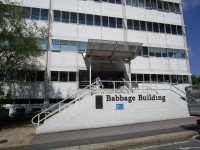Access Guide
Introduction
- This is a route from the Smeaton Building to the Babbage Building.
- The route is approximately 150m long.
- It takes less than 5 minutes to complete the route.
- Most of the route is pedestrianised or the service road and users need to cross where the service road turns between buildings.
- There are dropped kerbs and tactile warnings.
- The final section of the route is on James Street.
- The pedestrianised area surface is block paved and pavements are tarmac.
- All the buildings are clearly named and there are some wall and finger signs.
- There is an alternative route from the West Entrance of the Smeaton Building to the Babbage Building.
- Throughout the campus, University vehicles may use the pedestrian areas.
- They are restricted to 5mph and the pedestrians have the right of way.
- The campus is situated on a hillside and there are sections of the route with moderately steep gradients.
Smeaton Building
Smeaton Building East Entrance to the Babbage Building
- After exiting the East Entrance, shown in photographs 1 and 2, of the Smeaton Building turn left towards the Charles Seale-Hayne Library.
- There is a dished gutter across the whole width of the walkway 3m from the Smeaton Building door, shown in photographs 3 and 4.
- After 10m turn left between the Smeaton Building and the Library.
- There is a temporary site office on the left of this area, shown in photographs 5 and 6.
- There are bicycle racks on the right side of the area with tactile paving along the edge.
- After 30m move to the right of the walkway and pass between the steel bollards (some of which are retractable).
- The bollards are 90cm high with contrast bands and are a minimum of 120cm apart, shown in photograph 7.
- There is level access to the zebra road markings, without any tactile warnings, then a dropped kerb and tactile warning on the far side of the service road which is quiet but could have slow moving vehicles coming from the left or right.
- The dropped kerb has a steep gradient up onto the pavement.
- This crossing is shown in photographs 8 and 9.
- Follow the pavement which is a concrete surface past the Brunel Building on your right.
- This pavement is shown in photographs 10 and 11.
- Continue for 30m to the junction with James Street.
- At the junction there is a dropped kerb with tactile warnings in the radius of the corner, shown in photographs 12 and 13.
- Cross James Street to the dropped kerb with tactile paving, shown in photograph 14, and sloping entrance path to the main entrance to the Babbage Building, shown in photograph 15 and 16, directly in front of you.
- James Street is fairly busy with traffic from both directions but there are speed restrictions throughout its length ensuring vehicles move at a low speed.
Smeaton Building West Entrance to James Street
- On exiting the West entrance of the Smeaton Building turn left onto the ramp, shown in photographs 1, 2 and 3, which bypasses the seven steps in front of the door.
- The ramp is easy and has a handrail on one side.
- The ramp is in three sections with level landings between them.
- The handrail is to the right on the first and third sections and the left on the middle section.
- In total the ramp is 30m long.
- At the bottom of the ramp turn right across the front of the building and go straight ahead for 10m to cross James Street, shown in photograph 4.
- The crossing has zebra markings, dropped kerbs and tactile warnings on both sides of the road, this crossing is shown in photographs 5 and 6.
- The road has traffic coming from both sides but there are speed restrictors throughout its length ensuring that vehicles travel at a low speed.
James Street to Babbage Building
- The James Street crossing has zebra markings, dropped kerbs and tactile warnings on both sides of the road.
- This crossing is shown in photographs 1 and 2.
- The road has traffic coming from both sides but there are speed restrictors throughout its length ensuring that vehicles travel at a low speed.
- After crossing James Street turn right across the front of the Marine Building.
- Immediately after you turn right there is a service vehicle entrance for the building with corduroy tactile paving shown in photographs 3 and 4.
- The footpath level does not change as shown in photograph 5.
- Continue along the footpath for 30m where there is a second service entrance without tactile markings, shown in photograph 6, leading immediately to the sloping entrance to the main entrance of the Babbage Building to your left, shown in photographs 7 and 8.
- The paving on this route is all block paving apart from the tarmac road surface.


